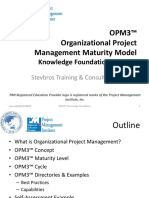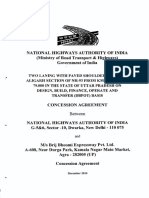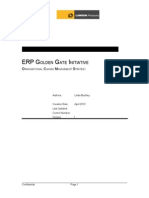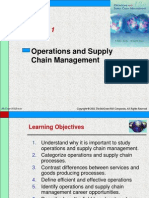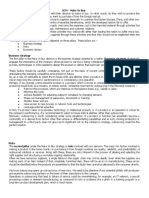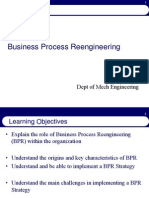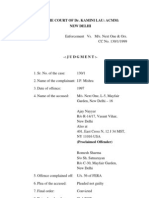Business Process Re Engineering
Uploaded by
jeetpajwaniBusiness Process Re Engineering
Uploaded by
jeetpajwani1
ERP enabled Business Process Re-engineering
Learning Objectives of the unit : Explain the role of Business Process Reengineering (BPR) within the organization Understand the origins and key characteristics of BPR ERP & BPR, Work Flow Management. FIVE STAGE AS IS / TO BE ANALYSIS.
What is BPR ?
Reengineering is the fundamental rethinking and radical redesign of business processes to achieve dramatic improvements in critical, contemporary measures of performance, such as cost, quality, service and speed. (Hammer & Champy, 1993)
The Need for BPR
Customers (know what they want and are willing to pay for it) Competition (Continuous increase will result in changes to price, quality, selective service, and delivery) Change (continues to occur in people & culture, organizational structures, policies & procedures, and technology)
The Need for BPR
Techniques lag behind technology (Technologically capable, but not functionally operational) Significant gap between the actual and desired results, creating a business Problem. Fragmented piecemeal systems (focus on vertical functions, with the existence of redundancies of effort and actions). Integration across departmental and organizational boundaries (information and operations are needed).
BPR is Not?
Automation Downsizing Outsourcing Process improvement projects / activities Continuous Improvement Activity Reorganizing
BPR Versus Process Simplification
Process Simplification Incremental Change Process-Led Assume Attitudes & Behaviors Management-Led Various Simultaneous Projects
Process Reengineering Radical Transformation Vision-Led Change Attitudes & Behaviors Director-Led Limited Number of Initiatives
(Source Coulson-Thomas, 1992)
BPR Versus Continuous Improvement
Continuous Improvement Incremental Change People Focus Low Investment Improve Existing Work Unit Driven
Process Reengineering Radical Transformation People & Technology Focus High Investment Rebuild Champion Driven
T Q M and Reengineering
Rate of change TQM: continuous improvement Reengineering: dramatic improvement
4-
TQM versus Reengineering
4-9
10
What is a Process?
A specific ordering of work activities across time and space, with a beginning, an end, and clearly identified inputs and outputs: a structure for action. (Davenport, 1993)
11
What is a Business Process???
A collection of activities that take one or more inputs and turn that into a product that adds value to a customer A group of logically related tasks that use the firm's resources to provide customer-oriented results in support of the organization's objectives
12
Why Organizations Dont Reengineer?
Complacency Political Resistance
New Developments
Fear of Unknown and Failure
13
Performance
BPR seeks improvements of
Cost Quality Service Speed
14
Key Characteristics
Systems Philosophy Global Perspective on Business Processes Radical Improvement Integrated Change People Centred Focus on End-Customers Process-Based
15
Key Characteristics
Several jobs are combined into one Employees are empowered to make decisions Steps in business process: natural order Process may have multiple versions Work is performed where it makes the most sense
16
Key Characteristics
Controls, checks, other non-value-added work is minimized Reconciliation is minimized - minimize external contact points Hybrid centralized / decentralized operation is used A single point of contact is provided for the customer
17
Systems Perspective
Feedback
Inputs
Transformation
Outputs
Environment
18
Process Based
Added Value
BPR Initiatives must add-value over and above the existing process
Customer-Led
BPR Initiatives must meet the needs of the customer
19
Radical Improvement
Sustainable
Process improvements need to become firmly rooted within the organization
Stepped Approach
Process improvements will not happen over night they need to be gradually introduced Also assists the acceptance by staff of the change
20
Integrated Change
Viable Solutions
Process improvements must be viable and practical
Balanced Improvements
Process improvements must be realistic
Enterprise integration
Departments are consolidated Several jobs are combined into one job \
21
People-Centred
Business Understanding Empowerment & Participation Organizational Culture Worker empowerment
There is both horizontal and vertical reorganization Handoffs are eliminated There are fewer rules and less coordination is required
22
Focus on End-Customers
Process improvements must relate to the needs of the organization and be relevant to the endcustomers to which they are designed to serve
23
Re-engineering
Redesign of processes (Fundamental change in business processes) From mass production to mass customization (Mass production of the same products --- Mass production of different products) Cycle time reduction (Change in the time it takes to complete a process from start to end; time can provide competitive advantage Restructuring organizations (May need to restructure the entire organization to reap the benefits of BPR)
24
Key Steps To BPR
Initiation - Select The Processes
Documenting the processes Understand The Current Process AS IS
Develop & Communicate Vision Of Improved TO BE Processes
IMPLEMENTATION of ERP enabled BPR
25
Initiation - Select the Process
Crucial Tasks
Persuasive Case for Action WHY BPR ? Select the Processes to be Reengineered Sponsorship / budget established Appoint the Project Team to Lead the Reengineering Initiative committed (full time Core team with extended team for support). Develop Project scope, plan and milestones A communication plan information flow
26
Select the Process
Review Business Strategy and Customer Requirements Select Core Processes Understand Customer Needs Dont Assume Anything
27
Appoint the Process Team
Appoint BPR Champion Identify Process Owners
Establish Executive Improvement Team
Provide Training to Executive Team
28
Core Skills Required
Capacity to view the organization as a whole Ability to focus on end-customers Ability to assume individual and collective responsibility Ability to challenge fundamental assumptions Courage to deliver and venture into unknown areas
29
Documenting the Current Processes
Document a Process using Michael Porters Value Chain
Michael E. Porter
30
The Porters Value Chain
Support activities
Primary activities
Inbound logistics Operations Outbound logistics Marketing and Sales Service Corporate infrastructure Human resources management Technology Development Procurement Materials receiving, storing, and distribution to manufacturing premises Transforming inputs into finished products. Storing and distributing products Promotions and sales force Service to maintain or enhance product value Support of entire value chain, e.g. general management planning, financing, accounting, legal services, government affairs, and QM Recruiting, hiring, training, and development Improving product and manufacturing process Purchasing input
30
31
Porters Value Chain
Administrative Coordination and Support Services SIS: Collaborative Work Systems
Support Processes
Human Resources Management SIS: Employee Skills Database Systems Technology Development SIS: Computer-Aided Engineering and Design
Procurement of Resources SIS: Electronic Data Interchange with Suppliers Marketing and Sales SIS: Interactive Targeted Marketing
Competitive Advantage Customer Service SIS: Help Desk Expert System
Inbound Logistics
Operations SIS: ComputerAided Flexible Manufacturing
Outbound Logistics SIS: Online Point-ofSale and Order Processing
Primary Business Processes
SIS: Automated Just-in-Time Warehousin g
31
32
Porters Value Chain
Primary Activities:
Inbound Logistics: Inbound activities to receive, store and distribute inputs to the product, such as material handling, inventory control, warehousing and contact with suppliers. Operations: Production activities to create the product such as machining, packaging, printing and testing. Outbound Logistics: Outbound activities to store and distribute the product to customers, including warehousing, order processing and vehicle scheduling. Marketing and Sales: Activities associated with providing a means by which buyers can purchase the product and be included to do so (advertising, selling, pricing, merchandising and promotion). Service: Activities for providing service or maintaining product value, including installation and training.
32
33
Porters Value Chain
Support Activities:
Procurement: Purchasing input. Technology Development: Not just machines and processes but also Human Resource Management: Activities involved in recruiting, training Infrastructure: General management, finance, planning and quality
assurance. Infrastructure supports the whole value chain.
and staff development.
expertise, procedures and systems.
33
34
Porters Value System
SUPPLIER VALUE CHAINS
FIRM VALUE CHAIN
CHANNEL VALUE CHAINS
BUYER VALUE CHAINS
In the value system supplier, firm, distributor, and buyer value chains overlap. The suppliers outbound logistics is the firms inbound logistics. The Distributors inbound logistics is the firms outbound logistics, etc.
34
35
IT managers care about these models The models provide a map to help managers Find where they are Find where they should go
You are here
The road to competitive advantage
Goal
36
Stage 3 Focus on AS IS Processes
Develop a Process Overview Clearly define the process Mission Scope Boundaries Set business and customer measurements Understand customers expectations from the process (staff including process team)
Carefully resolve any inconsistencies Existing -- New Process Ideal -- Realistic Process
37
Stage 3 Focus on AS IS Processes
Clearly Identify Improvement Opportunities
Quality Rework
Document the Process (PROCESS MAPS)
Cost Time Value Data
38
Stage 3 Focus on AS IS Processes
PROCESS ASSESSMENT
LOOK FOR ELIMINATING REDUNDANCY, BUREAUCRACY, NON-VALUE ADDING ACTIVITIES, ERRORS / DEFECTS, REDUCE CYCLE TIME,
39
Develop & Communicate Vision of Improved Process
Communicate with all employees so that they are aware of the vision of the future Always provide information on the progress of the BPR initiative - good and bad. Demonstrate assurance that the BPR initiative is both necessary and properly managed
40
Develop & Communicate Vision of Improved Process
Promote individual development by indicating options that are available Indicate actions required and those responsible Tackle any actions that need resolution Direct communication to reinforce new patterns of desired behavior
41
Identify Action Plan
Develop an Action Plan Appoint Process Owners
Simplify the Process to Reduce Process Time
Remove any Bureaucracy that may hinder implementation
42
Identify Action Plan
Remove no-value-added activities Standardize Process and Automate Where Possible Up-grade Equipment Plan/schedule the changes Construct in-house metrics and targets Introduce and firmly establish a feedback system Audit, Audit, Audit
43
IMPLEMENT Plan
Qualify/certify the process Perform periodic qualification reviews Define and eliminate process problems Evaluate the change impact on the business and on customers Benchmark the process Provide advanced team training
44
ERP & BPR
45
Benefits From ERP
Assists the Implementation of Business Processes
Access to Global Best Practices for various processes which are proven and standardized. Provides integrated approach enhancing the focus on customer requirements / fulfillment Improve Operational Efficiency Coordinate with Vendors & Customers in the Process Chain ERP & BPR go hand in hand. ERP to be used to Innovate.
46
ERP IN MODELLING BUSINESS PROCESSES
Focus
Business Processes Process Redesign Process Implementation Integration of all functions / across divisions Information flow accurate & on-time MIS reports for facilitating decision making/actions Used to automate transactional and laborious business processes.
47
WORK FLOW MANAGEMENT SYSTEM IN ERP
Work Flow (Routing) system in ERP is an automated organizational process facilitating communication of work content, coordination between departments / people and control of processes. WFM integrates : Technology Organization / divisions Methodology (processes) Collaboration of Business processes. Communication within / outside using SCM / CRM etc., Human interaction reqd. to meet customer requirements.
48
TASKS of the Re-engineering team
1) determine measures of performance 2) install measures of performance 3) delineate entire existing process in all its gory detail 4) perform process value analysis and activity-based costing 5) benchmark processes by comparison with other processes
49
Contd
6) design re-invented process 7) simulate re-invented process 8) prepare report with recommendations 9) install re-invented process 10) measure improvements
50
BPR Challenges
51
Continuous Evaluation
Is reengineering truly transformational? Will reengineering improve customer relations? Has reengineering cut across the organization? Is information technology playing an integral role in the reengineering solution? Does it hurt?
4-51
52
Common Problems
Process Simplification is Common - True BPR is Not Desire to Change Not Strong Enough Starting Point is the Existing Process & Not a Blank Slate Commitment to Existing Processes Too Strong Quick Fix Approach
53
Common Problems with BPR
Process under review too big or too small Reliance on existing process too strong The Costs of the Change Seem Too Large BPR Isolated Activity not Aligned to the Business Objectives Allocation of Resources Poor Timing and Planning Keeping the Team and Organization on Target
54
Managerial Issues
Ethical issues (BPR projects may lead to the need to lay-off, retrain, or transfer employees) BPR implementation (Few organization-wide BPR effort) Incremental improvement programs BPR tools (Often uses existing tools rather than creation of new tools) Role of IT (IT should be a supportive, not lead role in BPR projects) Failures (Big projects tend to increase failure rates)
55
BPR Symbols
56
Business Process Flowchart Symbols
An Activity A Document
A Decision
Data (input as outputs)
57
Business Process Flowchart Symbols
A Predefined Process Start The Start of a Process The End of a Process Representing a Relation
End
58
Business Process Flowchart Symbols
Continuation of the process at the same page at an equal symbol with the same number. Used when a relation arrow crosses another relation arrow Off-Page Connector - Process will continue on the next page
Integration Relation - A relation to another module is identified and described
59
Data Flowchart Symbols
Manual Data Item A Database File Representing a Relation Continuation Off-Page Connector
60
Rules For Data Symbols
61
Rules For Data Symbols
Start
Generate Purchase Order
Symbol used to identify the start of a business process Activities must be described as a verb Decisions have only two possibilities (Yes & No)
OK?
Yes
No Crossing lines are not allowed If one side of the decision has no further processes defined this symbol has to be used
End
62
Rules For Data Symbols
I Continuation symbol within the same number must be present twice on the same page Name the document Off- Page Connector is used to continue a process at the next page or to let the process to flow over at the previous to the next page. If more than one is needed use A, B, C, D Name the data
Purchase Order
Posting of Bonus
63
Rules For Data Symbols
Predefined Processes always have a relation to level and stream by a number in the line below a sub-process description A predefined process must be described in a different flowchart. To make the relation clear between the predefined process and the belonging flowchart a unique alpha numeric number should be assigned to this predefined process.
Sub-Process Delivery
BC 4.04
64
Version Management
For different versions of a business process or data flow some mandatory information must be on the flowchart.
Name of the business process Unique number of the business process Revision number Date of last change Author Page number with total pages
65
Summary
Reengineering is a fundamental rethinking and redesign of business processes to achieve dramatic improvements BPR has emerged from key management traditions such as scientific management and systems thinking
Rules and symbols play an integral part of all BPR initiatives
You might also like
- OPM3™ Organizational Project Management Maturity Model: Knowledge Foundation by PMI®No ratings yetOPM3™ Organizational Project Management Maturity Model: Knowledge Foundation by PMI®30 pages
- Two Laning of Agra - Aligarh Section of NH 93 in The State of Uttar PradeshNo ratings yetTwo Laning of Agra - Aligarh Section of NH 93 in The State of Uttar Pradesh493 pages
- Project Name: Cycle Time Reduction. Project Owner: S.N. Parmar, Ajay Kumar Choudhari100% (1)Project Name: Cycle Time Reduction. Project Owner: S.N. Parmar, Ajay Kumar Choudhari50 pages
- Bou-Llusar Et Al 2009 EFQM Excellence ModelNo ratings yetBou-Llusar Et Al 2009 EFQM Excellence Model22 pages
- What Is Inventory Management Process? Flow ExplainedNo ratings yetWhat Is Inventory Management Process? Flow Explained9 pages
- Talent Management: Effective and Future StrategiesNo ratings yetTalent Management: Effective and Future Strategies30 pages
- BROCHURE Certified Lean Six Sigma Yellow Belt Course Sept 2019No ratings yetBROCHURE Certified Lean Six Sigma Yellow Belt Course Sept 20192 pages
- Standard Operating Procedure For Customer CreationNo ratings yetStandard Operating Procedure For Customer Creation3 pages
- Procure: Production Procurement ManagementNo ratings yetProcure: Production Procurement Management4 pages
- Segmenting The Business Market and Estimating Segment DemandNo ratings yetSegmenting The Business Market and Estimating Segment Demand81 pages
- Key Phrases For Leading Confcalls: A Book From The Series byNo ratings yetKey Phrases For Leading Confcalls: A Book From The Series by14 pages
- From Conceptual To Executable BPMN Process Models: A Step-by-Step MethodNo ratings yetFrom Conceptual To Executable BPMN Process Models: A Step-by-Step Method27 pages
- Six Sigma: By:-Amulya Kalia 400907002 INE-1No ratings yetSix Sigma: By:-Amulya Kalia 400907002 INE-123 pages
- Main Components: Quality Planning, Quality Assurance, QualityNo ratings yetMain Components: Quality Planning, Quality Assurance, Quality6 pages
- Lean Strategy Implementation MethodologyNo ratings yetLean Strategy Implementation Methodology48 pages
- Outsourced Manufacturing Within The Current Global MarketplaceNo ratings yetOutsourced Manufacturing Within The Current Global Marketplace18 pages
- Business Process Reengineering: M. Parthiban Dept of Mech EngineeringNo ratings yetBusiness Process Reengineering: M. Parthiban Dept of Mech Engineering60 pages
- Enterprise Resource Planning: Unit Ii - Building Business Cases For ErpNo ratings yetEnterprise Resource Planning: Unit Ii - Building Business Cases For Erp52 pages
- Understanding Enterprise Resource Planning SystemsNo ratings yetUnderstanding Enterprise Resource Planning Systems25 pages
- Models of Organizational Behaviour: Group 1No ratings yetModels of Organizational Behaviour: Group 117 pages
- Amended By-Laws of The Association of Senior Citizen of Barangay One, Tumauini, Isabela100% (6)Amended By-Laws of The Association of Senior Citizen of Barangay One, Tumauini, Isabela3 pages
- Market Economies and Market Societies: Frank CunninghamNo ratings yetMarket Economies and Market Societies: Frank Cunningham14 pages
- Cash in Hand 800 Cash in Bank 0 July Budget & Savings 25000 Fixed Expenses Budgeted Actual Fixed Exp Varib. Exp 8800No ratings yetCash in Hand 800 Cash in Bank 0 July Budget & Savings 25000 Fixed Expenses Budgeted Actual Fixed Exp Varib. Exp 88003 pages
- Graphing Systems of Inequalities Word Problems WsNo ratings yetGraphing Systems of Inequalities Word Problems Ws10 pages
- OPM3™ Organizational Project Management Maturity Model: Knowledge Foundation by PMI®OPM3™ Organizational Project Management Maturity Model: Knowledge Foundation by PMI®
- Two Laning of Agra - Aligarh Section of NH 93 in The State of Uttar PradeshTwo Laning of Agra - Aligarh Section of NH 93 in The State of Uttar Pradesh
- Project Name: Cycle Time Reduction. Project Owner: S.N. Parmar, Ajay Kumar ChoudhariProject Name: Cycle Time Reduction. Project Owner: S.N. Parmar, Ajay Kumar Choudhari
- What Is Inventory Management Process? Flow ExplainedWhat Is Inventory Management Process? Flow Explained
- Talent Management: Effective and Future StrategiesTalent Management: Effective and Future Strategies
- BROCHURE Certified Lean Six Sigma Yellow Belt Course Sept 2019BROCHURE Certified Lean Six Sigma Yellow Belt Course Sept 2019
- Standard Operating Procedure For Customer CreationStandard Operating Procedure For Customer Creation
- Segmenting The Business Market and Estimating Segment DemandSegmenting The Business Market and Estimating Segment Demand
- Key Phrases For Leading Confcalls: A Book From The Series byKey Phrases For Leading Confcalls: A Book From The Series by
- From Conceptual To Executable BPMN Process Models: A Step-by-Step MethodFrom Conceptual To Executable BPMN Process Models: A Step-by-Step Method
- Main Components: Quality Planning, Quality Assurance, QualityMain Components: Quality Planning, Quality Assurance, Quality
- Outsourced Manufacturing Within The Current Global MarketplaceOutsourced Manufacturing Within The Current Global Marketplace
- Business process validation Standard RequirementsFrom EverandBusiness process validation Standard Requirements
- Business Process Reengineering: M. Parthiban Dept of Mech EngineeringBusiness Process Reengineering: M. Parthiban Dept of Mech Engineering
- Enterprise Resource Planning: Unit Ii - Building Business Cases For ErpEnterprise Resource Planning: Unit Ii - Building Business Cases For Erp
- Understanding Enterprise Resource Planning SystemsUnderstanding Enterprise Resource Planning Systems
- Amended By-Laws of The Association of Senior Citizen of Barangay One, Tumauini, IsabelaAmended By-Laws of The Association of Senior Citizen of Barangay One, Tumauini, Isabela
- Market Economies and Market Societies: Frank CunninghamMarket Economies and Market Societies: Frank Cunningham
- Cash in Hand 800 Cash in Bank 0 July Budget & Savings 25000 Fixed Expenses Budgeted Actual Fixed Exp Varib. Exp 8800Cash in Hand 800 Cash in Bank 0 July Budget & Savings 25000 Fixed Expenses Budgeted Actual Fixed Exp Varib. Exp 8800




